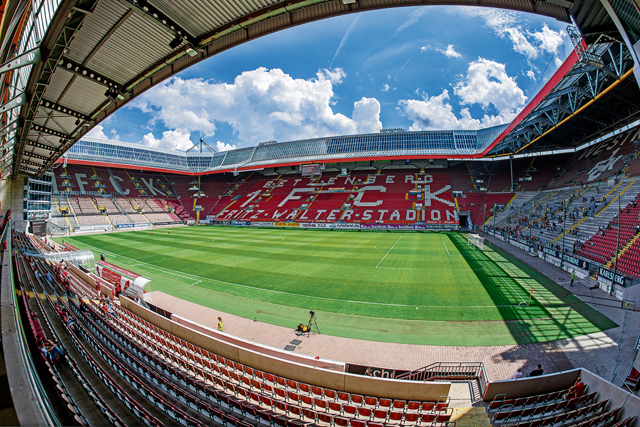
Germany is the host of the European Soccer Championship this year, with the first of 51 matches in Munich against Scotland June 14. While the Federal Republic has a successful history in terms of Europe’s most popular ball game, it also brought about a number of world class players, such as Franz Beckenbauer, who recently passed away. But, did you know that one of the most prominent soccer players came from nearby Kaiserslautern?
Fritz Walter and his brother Ottmar were born and raised in Alsenborn. They came to fame as prominent German soccer players in the 1950’s. Together with Horst Eckel of Vogelbach, they starred in the World Soccer Cup in 1954 when Germany won the championship. They not only brought fame to themselves, but shaped following generations of dedicated and passionate soccer fans in Kaiserslautern and the region, sometimes referred to as the “red devils” based on their red team color.
Not known by many, Fritz was drafted into the German Wehrmacht at Daenner Kaserne in 1940, stationed at various bases around Europe and eventually served in the 2nd Company Fortress Battalion 902, responsible for Sardinia and Corsica. During his time in service, he had a very adventurous time as soccer player and played in various formations as “guest player” with the 1. Fussball Club Kaiserslautern (1. FCK).
In 1945 he was taken as a prisoner of war, encamped in Romania, and according to his autobiography, a severe case of malaria and an impromptu soccer game with two camp guards, saved him from being deported to Siberia.
Upon his return, he played on various teams in southwest Germany, then with the 1. FCK and was appointed as team captain of the German national team. About this time, he met Italia from Belluno, Italy, discovered another passion and married her in 1948. Though he was first criticized just shortly after the war and Italy being Germany’s most feared competitor, fans soon found a special place in their hearts for Italia as well.
The zenith of his career was Germany’s World Championship in Switzerland in 1954 when they scored the winning goal six minutes before the end of the match against England and is commonly called the “Miracle of Bern.” The team is still referred to as the “Walter Elf” and the formation “Elf Freunde” (eleven friends) was erected with statues of him and his teammates in a traffic circle leading to the stadium, close to the train station in Kaiserslautern.
Italia died after over 50 years of marriage in 2001 and Fritz once stated that this was the most tragic day of his life. Luckily, he was able to hand sign a bronze soccer ball placed at the Kaiserbrunnen at Mainzer Tor in Kaiserslautern. He also passed away just a year later at the age of 82 and it is said that it was because of his broken heart. He was placed in an honorary grave next to his beloved wife Italia at the main cemetery near Daenner Kaserne.
It is unfortunate that he didn’t live to see Kaiserslautern as the venue of the 2006 Soccer World Cup in Germany. Kaiserslautern was the smallest of the 12 cities to host games and during four weeks from June to July the city turned into one colorful festival which Fritz would have loved to see. Autobahn A6 was widened to three lanes, construction and beautification projects were carried out throughout the city. Betzenberg stadium was enlarged to meet FIFA standards and renamed “Fritz-Walter-Stadion” in his honor.
Players and fans from around the globe began to flock to the city, the U.S. team, that scored a tie against Italy, was accommodated at Ramstein Air Base. Sheiks from Saudi Arabia were flown in with helicopters, the king and queen of Spain were welcomed at the DV Ramp at Ramstein Air Base, and shuttles from the base to the stadium were run to avoid traffic chaos.
The whole city turned into one big fiesta with great weather, daily parades took place with the countries playing showcasing their talent with drum groups or cheerful dance ensembles and typical music. Trinidad and Tobago paraded through the city in exotic and colorful costumes resembling dragon flies. It is said that there were more (plastic inflatable) kangaroos on the streets than in Australia and fans of countries from around the world celebrated peacefully with colorful flags for four weeks, and at times there were more guests than the 100,000 inhabitants of Kaiserslautern. The championship was topped off by Germany again winning at the finals in Berlin July 9, 2006.
Germany is already setting up for the UEFA EM 2024 events with the kick-off in Munich June 14. The Brandenburg Gate in Berlin will be turned into a giant soccer goal, the street leading up to it will be covered with artificial grass, and hundreds of thousands of soccer enthusiasts are expected to be infected with Fussballfieber.
Whether Germany wins the European championship in Berlin July 14 is yet to be seen, but fans can look forward to a lively and exiting four weeks of fussball, fun and fiesta!
For a full schedule, visit: https://www.uefa.com/euro2024/news/0275-151eb1c333ea-d30deec67b13-1000–uefa-euro-2024-fixtures-when-and-where-are-the-matches/


